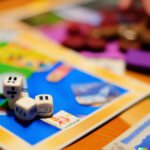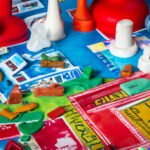Scrabble Classic Kids Board Games have been captivating children and families for decades. This article delves into the enduring popularity of this classic board game, as well as its educational and developmental benefits. From its origins to gameplay strategies, variations to testimonials, get ready to explore all things Scrabble Classic Kids Board Games.
Scrabble has stood the test of time, captivating young minds since its inception. Its appeal lies in the perfect combination of fun and learning. As children engage in friendly competition, they simultaneously develop important skills such as language mastery, vocabulary expansion, and spelling abilities.
In this article, we will explore the rich history of Scrabble Classic Kids Board Games. Discover how this beloved game has evolved over the years to cater specifically to children. We will also discuss the rules and scoring system in a child-friendly manner, ensuring that little ones can easily understand and enjoy playing this timeless board game.
So whether you’re a parent looking for an engaging way for your child to enhance their cognitive abilities or simply seeking a family activity that combines entertainment with education, join us on this journey through the world of Scrabble Classic Kids Board Games. Get ready to unlock your wordplay potential.
History of Scrabble Classic Kids Board Games
The game of Scrabble has a rich history, and its journey as a classic children’s board game is an interesting one. Originally created for adults in the early 1930s by architect Alfred Mosher Butts, Scrabble quickly gained popularity and became a household name. However, it wasn’t until the mid-1950s that Scrabble was adapted and modified specifically for kids.
Origins and Evolution of Scrabble
Scrabble was initially called “Lexiko” and later renamed “Criss-Cross Words” before it acquired its now-famous name. In 1948, James Brunot purchased the rights to manufacture the game and made some important changes that would shape Scrabble into what it is today. Not only did he tweak the rules and point distribution, but he also introduced the distinctive wooden tiles and the gameboard we are familiar with.
By the 1950s, Scrabble had gained significant popularity among adults who appreciated its challenging wordplay. Recognizing this success, companies saw an opportunity to bring this beloved game to younger audiences as well. With slight modifications made to accommodate children’s abilities and skill levels, Scrabble Classic Kids Board Games entered the scene.
Adapting Scrabble for Kids
Scrabble Classic Kids Board Games were designed to be more accessible for children while still maintaining the educational benefits of the original game. The vocabulary used in these editions was tailored to suit younger players, with simpler words included in each set. Additionally, colorful illustrations were added to make the tiles visually engaging and appealing to kids.
To capture children’s attention even further, variations such as Junior Scrabble and My First Scrabble were introduced. These versions incorporated themes like animals or famous characters from popular movies or TV shows. By infusing playfulness into the gameplay experience, these adaptations aimed to spark imagination and creativity while reinforcing vital language skills.
Over the years, with advancements in technology, Scrabble Classic Kids Board Games have also made their way into digital formats. These interactive versions retain the essence of the original game while incorporating kid-friendly graphics and features that provide an engaging digital experience for young players.
The evolution of Scrabble into a game specifically tailored to children has ensured its enduring popularity through generations. Not only does it stand as a testament to the adaptability and innovation of this classic board game, but it also reinforces its status as a timeless educational tool and a source of fun for kids.
How to Play Scrabble Classic Kids Board Games
Scrabble Classic Kids Board Games are not only enjoyable but also offer numerous educational benefits. Learning how to play this game is easy and can be a fun bonding activity for the whole family. Here is a step-by-step guide on how to set up and play Scrabble Classic Kids Board Games:
Setting Up
- Start by laying out the game board on a flat surface.
- Each player should take a tile rack and choose seven letter tiles from the bag.
- Place the remaining tiles face-down in the bag and mix them up.
- Determine who goes first, either by tossing a coin or any agreed method.
Playing the Game
- The player who goes first forms a word using any or all of their tiles and places it on the board, making sure that one letter overlaps with an existing word if there is one.
- The next player then forms their own word using one or more of their tiles, incorporating at least one of the letters in the previous word.
- This process continues clockwise around the board, with each player adding their words as they take turns.
Rules and Scoring
- Words can be formed vertically or horizontally, but cannot be placed diagonally.
- All words must be real words found in a standard dictionary. Proper nouns, abbreviations, prefixes, or suffixes are not allowed unless they appear as separate entries in the dictionary.
- Earn points based on the total value of individual letters used in each word. Some letters have higher point values than others. Additionally, special spaces on the game board can double or triple the value of a letter or word played on them.
- Refill your tile rack with new letters from the bag once you have used your existing tiles, until there are no more tiles left.
- The game ends when all players have used all their tiles or when there are no more legal word placements on the board.
- The player with the highest score wins.
By following these simple guidelines, children can easily learn how to play Scrabble Classic Kids Board Games. The game not only promotes critical thinking and strategic planning but also helps children expand their vocabulary and improve their language skills.
Educational Benefits of Scrabble Classic Kids Board Games
Scrabble Classic Kids Board Games go beyond providing entertainment for children; they also offer numerous educational benefits. Playing Scrabble can enhance language skills, vocabulary, and spelling abilities in children. As they form words and strategize their moves, kids are constantly thinking and expanding their knowledge of the English language.
One major educational benefit of Scrabble is its ability to improve language skills. By playing this game, children are exposed to a wide range of vocabulary words that they may not encounter in everyday conversations. They have the opportunity to learn new words and understand their meanings in a fun and engaging way. Additionally, as children strive to create longer and more complex words, their understanding of word structure and syntax improves, leading to better sentence formation.
Moreover, Scrabble helps children develop their spelling abilities. Spellings become ingrained in a child’s memory as they repeatedly spell words correctly during gameplay. This can help reinforce correct spelling patterns and improve overall spelling competence. Research has shown that playing word games like Scrabble can significantly enhance spelling skills in children.
In a study published in the Journal of Experimental Education, researchers found that students who played word games like Scrabble scored higher on standardized tests measuring reading proficiency compared to those who did not play such games. This further emphasizes the positive effects that playing Scrabble can have on a child’s educational development.
Overall, Scrabble Classic Kids Board Games provide an enjoyable platform for children to strengthen their language skills, expand their vocabulary, and improve their spelling abilities. Whether played with friends or family members, this game offers an entertaining way for kids to engage with language while reaping significant educational benefits.
| Benefit | Data |
|---|---|
| Improved Language Skills | Expands vocabulary and enhances sentence formation |
| Enhanced Spelling Abilities | Reinforces correct spelling patterns and improves overall spelling competence |
| Higher Reading Proficiency | Increase in standardized test scores measuring reading proficiency |
Tips and Tricks for Winning Scrabble Classic Kids Board Games
Scrabble Classic Kids Board Games can be a fun and challenging activity for children, but winning the game can sometimes be a tricky task. In this section, we will provide some tips and tricks that can help children improve their gameplay and increase their chances of winning. By implementing these strategies, kids can enhance their vocabulary and spelling abilities while having a great time with this timeless board game.
One key strategy in Scrabble Classic Kids is to focus on forming high-scoring words. Encourage children to prioritize using letters with higher point values, such as Q, X, Z, or J. Additionally, guide them to create longer words as they tend to result in higher scores. For instance, instead of using three separate tiles to spell “cat,” they could use those tiles to form “catch” or “cats”.
Another useful tip is to look for opportunities to create bonus words by utilizing existing letters on the board. Children can connect their newly formed word with an existing word already on the board, creating two or more words at once for extra points. It’s important to remind them that these bonus words should be valid English words.
Furthermore, understanding the letter distribution in Scrabble Classic Kids can give players an advantage. Inform children about the number of each letter tile in the game so they know which letters are more likely to appear. For example, there are only one or two tiles with high-point letters like Q or Z, while vowels like A and E have multiple copies.
| Tip | Description |
|---|---|
| Focusing on High-Scoring Words | Prioritize using letters with higher point values and aim to create longer words. |
| Creating Bonus Words | Look for opportunities to connect newly formed words with existing words on the board to score extra points. |
| Understanding Letter Distribution | Familiarize with the number of each letter tile in the game to identify which letters are more likely to appear. |
By incorporating these strategies into their gameplay, children can not only enjoy Scrabble Classic Kids Board Games but also develop valuable language skills and strategic thinking abilities.
Popular Variations and Editions of Scrabble Classic Kids Board Games
Scrabble Classic Kids Board Games have been adapted and modified over the years to cater specifically to kids. There are several popular variations and editions of Scrabble that make it even more engaging and enjoyable for children. These versions add unique features and elements to the game, adding an extra level of excitement and challenge. Here are some of the most popular variations and editions of Scrabble Classic Kids Board Games:
Scrabble Junior
Scrabble Junior is a simplified version of the classic game designed for younger children. It introduces a two-sided game board, with one side featuring a pre-printed grid where players match letter tiles to create words. The other side is blank, allowing more advanced players to form words freely. This version also includes “extra word” cards that can be played for bonus points, making it easier for younger kids to score while learning spelling and vocabulary.
Super Scrabble
Super Scrabble is a larger version of the original game, with a bigger game board and twice as many letter tiles as the standard edition. This allows for longer words and more strategic play. Super Scrabble also introduces quadruple word score spaces, giving players an opportunity to score even higher points. This edition is suitable for older children who want a more challenging gaming experience.
Scrabble Slam
Scrabble Slam is a fast-paced card game variation of Scrabble that requires quick thinking and word building skills. Each player starts with a hand of five cards, each representing a different letter. A four-letter word card is placed in the middle of the table, and players take turns playing their cards onto it to create new words. The goal is to use up all your cards first by changing one or more letters at each turn.
These are just a few examples of the many variations and editions available for Scrabble Classic Kids Board Games. Each version offers a different twist on the original game, ensuring that children never get bored and can continue to challenge themselves as their skills improve. Whether it’s Scrabble Junior for beginners or Super Scrabble for more advanced players, there is a suitable edition for every child to enjoy.
Testimonials and Reviews from Parents and Kids
Scrabble Classic Kids Board Games have been delighting both parents and children for generations. Countless families have shared their positive experiences with the game, praising its entertainment value and educational benefits. Here are some testimonials and reviews from parents and kids who have enjoyed playing Scrabble Classic Kids Board Games:
- Parent Testimonial – “Playing Scrabble with my kids has become our favorite family pastime. Not only does it bring us together, but it also helps enhance their vocabulary and spelling skills. It’s amazing to see how they’ve improved over time while having so much fun.” – Sarah M.
- Kid Testimonial – “I used to struggle with spelling in school, but ever since I started playing Scrabble, my spelling has improved dramatically. Plus, it’s so much fun trying to come up with new words and challenge my friends to beat me.” – Ethan T., age 10.
- Parent Review – “As a teacher, I highly recommend Scrabble Classic Kids Board Games for its educational value. It fosters critical thinking skills, strategic planning, and word formation abilities in a playful way. My daughter loves competing against her friends while expanding her vocabulary at the same time.” – Emily R.
- Kid Review – “Scrabble is not just a board game; it’s like a secret code-cracking adventure. When I find that perfect word combination, it feels like unlocking a treasure chest of high points. I love challenging my sister every weekend; we have the best battles.” – Ava S., age 12.
These testimonials and reviews shed light on the enduring impact of Scrabble Classic Kids Board Games on both children’s development and family bonding moments. The game is cherished by many for its ability to entertain, educate, and create lasting memories for all involved.
Parents who are considering introducing Scrabble Classic Kids Board Games to their families can be reassured by the positive experiences shared by others. It is a game that not only brings joy but also promotes essential skills such as language development, critical thinking, and strategic planning.
Creative Ways to Make Scrabble Classic Kids Board Games More Fun
Playing Scrabble Classic Kids Board Games is already a fun and engaging activity for children, but there are also various ways to make it even more enjoyable and exciting. By adding twists and variations to the game, you can keep the gameplay fresh and stimulate your child’s creativity.
One creative idea is to have themed rounds, where players can only create words related to a specific topic or category. For example, you could have a round dedicated to animals or another round focused on food.
Another way to make Scrabble Classic Kids Board Games more fun is by incorporating DIY projects and customization options. Encourage your child to personalize their tiles by decorating them with stickers or drawings. You can also create handmade tile holders using cardboard or other materials, adding a personal touch to the game setup. These personalized elements not only make the game visually appealing but also allow your child to express their creativity.
Additionally, you can turn Scrabble Classic Kids Board Games into a collaborative experience by playing in teams. This enhances teamwork skills and promotes communication among players as they work together to arrange their tiles and form words. Playing in teams can also add an element of competition as each team tries to outscore the other.
In conclusion, Scrabble Classic Kids Board Games provide countless opportunities for learning, entertainment, and family bonding. By applying creative ideas and innovative variations, you can elevate the gaming experience even further. Whether it’s themed rounds, DIY projects, or collaborative play, these additional elements will surely enhance your child’s enjoyment of this timeless classic board game while fostering valuable skills along the way.
Frequently Asked Questions
Is there a kids version of Scrabble?
Yes, there is a kids version of Scrabble called “Scrabble Junior.” This version is specifically designed for younger children who are just beginning to learn how to read and spell. The game includes two different levels of play, allowing kids to progress from a more picture-based approach to the traditional letter-based gameplay.
The rules are simplified and the board is smaller, making it more accessible and engaging for younger players. Overall, Scrabble Junior provides a fun and educational way for kids to develop their vocabulary and word-building skills.
Can a 6 year old play Scrabble?
While it depends on the individual child’s abilities and interests, most 6-year-olds can certainly learn to play Scrabble with some guidance and support. At this age, children are typically expanding their vocabulary and starting to grasp spelling concepts. Playing Scrabble can be a valuable learning experience where they can practice letter recognition, spelling words, and even basic strategy.
However, it’s important to keep in mind that younger players may need assistance or adaptations in terms of understanding rules or finding suitable words based on their reading level. With parental involvement or playing in a family setting, Scrabble can be an enjoyable and educational game for 6-year-olds.
Is Scrabble good for 7 year olds?
Yes, Scrabble is generally considered appropriate and beneficial for 7-year-olds as they continue developing language skills. At this age, children have likely built a solid foundation in phonics and reading comprehension. Scrabble offers an opportunity for them to apply these skills while expanding their vocabulary further through word exploration during gameplay.
Additionally, playing Scrabble promotes important cognitive abilities such as critical thinking, problem-solving, strategic planning, and decision-making – all of which contribute towards their overall intellectual development. It’s worth encouraging 7-year-olds’ participation in Scrabble games as it can enhance their language proficiency while providing an enjoyable activity that the whole family can engage in together.

I love playing all kinds of games – from classics like Monopoly to modern favourites like Ticket to Ride.
I created this blog as a way to share my love of board games with others, and provide information on the latest releases and news in the industry.





